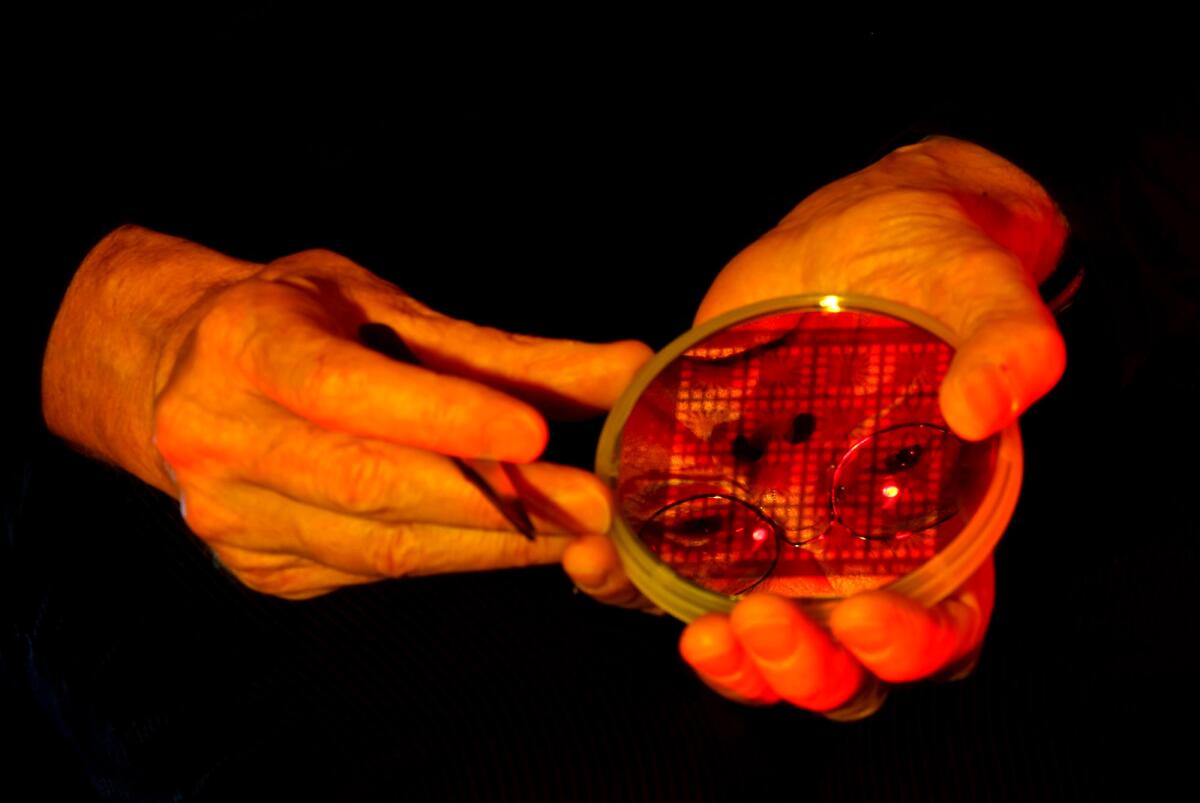Taking a step toward a machine that can think
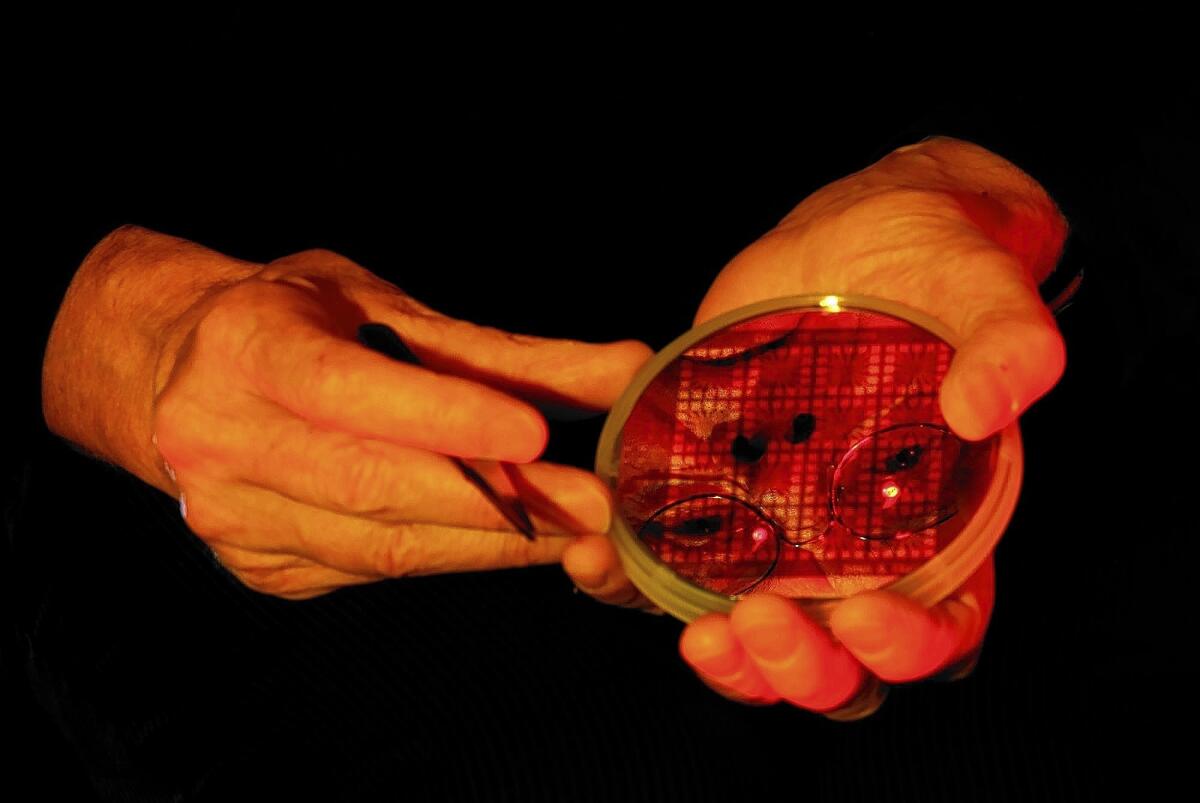
A chip developed by UCLA professor Jim Gimzewski carries an ugly tangle of wires. But it demonstrates an ability to remember.
Jim Gimzewski grabs a silicon wafer with a pair of tweezers and raises it to the light, thinking about Jackson Pollock, snowflakes and Tibetan mandalas.
No bigger than a quarter, the wafer looks like a small circuit board with a dozen or so electrodes converging at a darkened center, which under a microscope is an ugly tangle of wires randomly crisscrossed and interwoven like hairs in a tiny dust ball.
He places it inside a box the size of a mini-fridge. He closes the lid, and one of his graduate students, Henry Sillin, begins to run electricity into the box. A nearby monitor shows a sine-wave. The dust ball, messy and anarchic as it is, has come to life.
Gimzewski is one step closer toward what he calls his final frontier: building a machine that can think.
His tousled hair, Scottish brogue and clandestine pack of Marlboros would give an impression of a hip madness to the claim — if the science wasn't working so well.
Sillin adjusts his computer and picks up another series of pulses, an exercise not unlike measuring the electrical activity of the brain with an electroencephalogram.
"We should have walked away," Sillin says, "but it never failed enough for us to give up."
Gimzewski, a professor of chemistry at UCLA with more than 30 years working in the field of nanotechnology, believes that the tangled design of the chip is the reason for its resilience. The synapses of the brain are, after all, similarly organic and just as untidy.
Colleagues have been skeptical. Some thought the dust ball would melt down or either stay permanently on or off. And compared with the conventional chip, with its orderly array of wires, it seems hardly capable of driving a pocket calculator.
Yet Gimzewski has faith in the nature of eccentric invention. "We're operating somewhere between chaos and order, somewhere on the edge of chaos," he says.
Conventional computers are ideal for making precise calculations, he says, but what about computing in less predictable environments? He speculates about the chip's potential for predicting the patterns of a forest fire or the gyrations in the stock market, even for operating a driverless car.
If his claims seem premature, he has reason to be encouraged. In one test, the dust ball demonstrated one of the hallmarks of intelligence. Without a program, without an integrated circuit, no lines of code or algorithm to provide a timely prompt — it was able to remember.

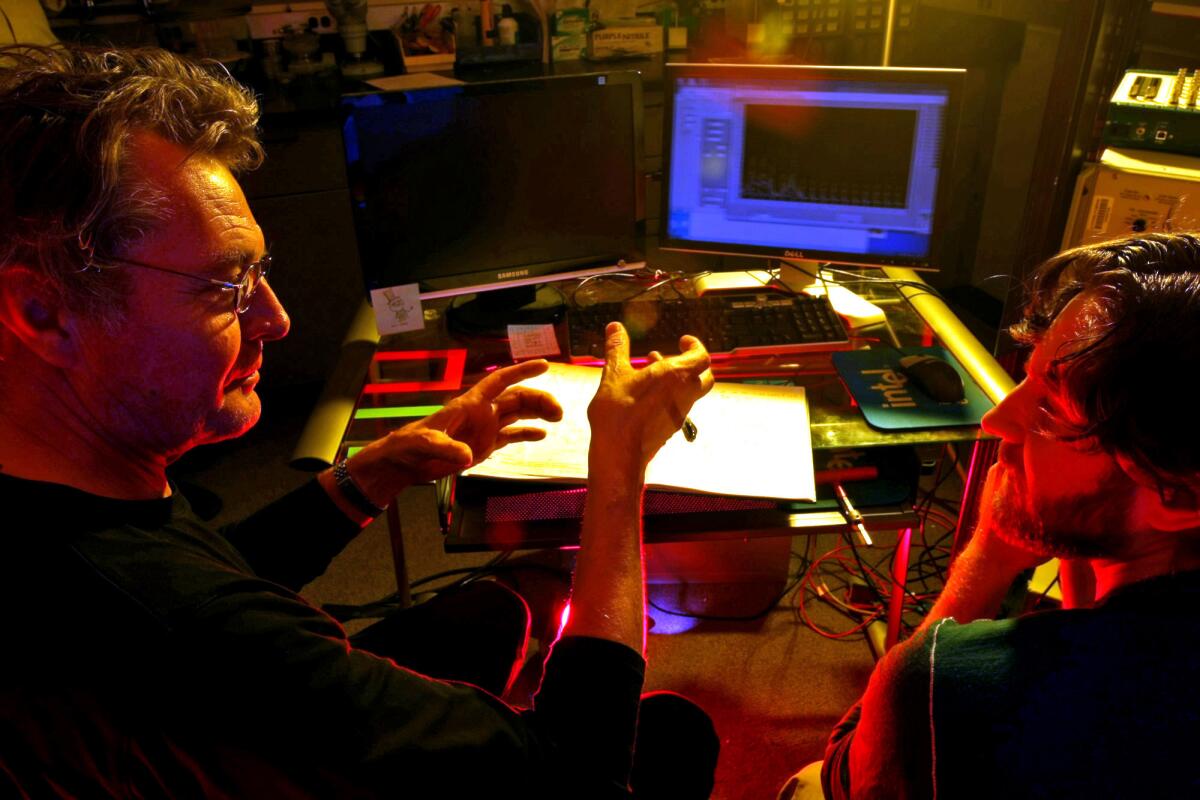
Gimzewski and Henry Sillin at work in their lab. The project is funded by the Pentagon's Defense Advanced Research Projects Agency and Japan's National Institute for Material Science. Bart Kosko, professor of electrical engineering at USC, said the Pentagon's backing is evidence that the research is "credible and certainly not kooky." More photos
Gimzewski, 62, lives at the top of Topanga Canyon. He shares the home with artist Victoria Vesna, with whom he has collaborated on a number of art installations.
"Imagination is more important than knowledge." The words are Albert Einstein's, but Gimzewski has posted them on his website. "For knowledge is limited, whereas imagination embraces the entire world, stimulating progress, giving birth to evolution."
His home has an ascetic simplicity, with a Spirograph-like mandala on one wall, a piano, a flat-panel TV, a futon and a bed. Sliding panels partition the rooms. In a corner are two Buddhas, focal points for his daily meditation, a practice he has kept, like yoga, for more than a decade.
Before coming to UCLA in 2001, Gimzewski worked nearly 20 years with IBM's research laboratory in Zurich. Under the guidance of Nobel laureate Heinrich Rohrer, Gimzewski explored the inner recesses of the atom.
"Astronomers look at stars and discover something new," Gimzewski says. "We looked at atoms and saw a landscape you can't imagine. At that scale you learn about relationships, how it's all interconnected."
Zurich was a big step for the young man who grew up in Glasgow, Scotland. His childhood neighborhood was grim, he says, recalling the row houses he lived in and the street gangs he tried to dodge. His home didn't have a telephone until he was 15. He found refuge in museums and work in a gas station. He spent his money on West Coast rock: records by Frank Zappa, Captain Beefheart.
If his home in Topanga is futuristic in its minimalism, his office at UCLA provides a glimpse of his past: awards from IBM, photographs of art projects, dusty notebooks and computers, Buddhist artifacts, plastic models of crystal molecules.
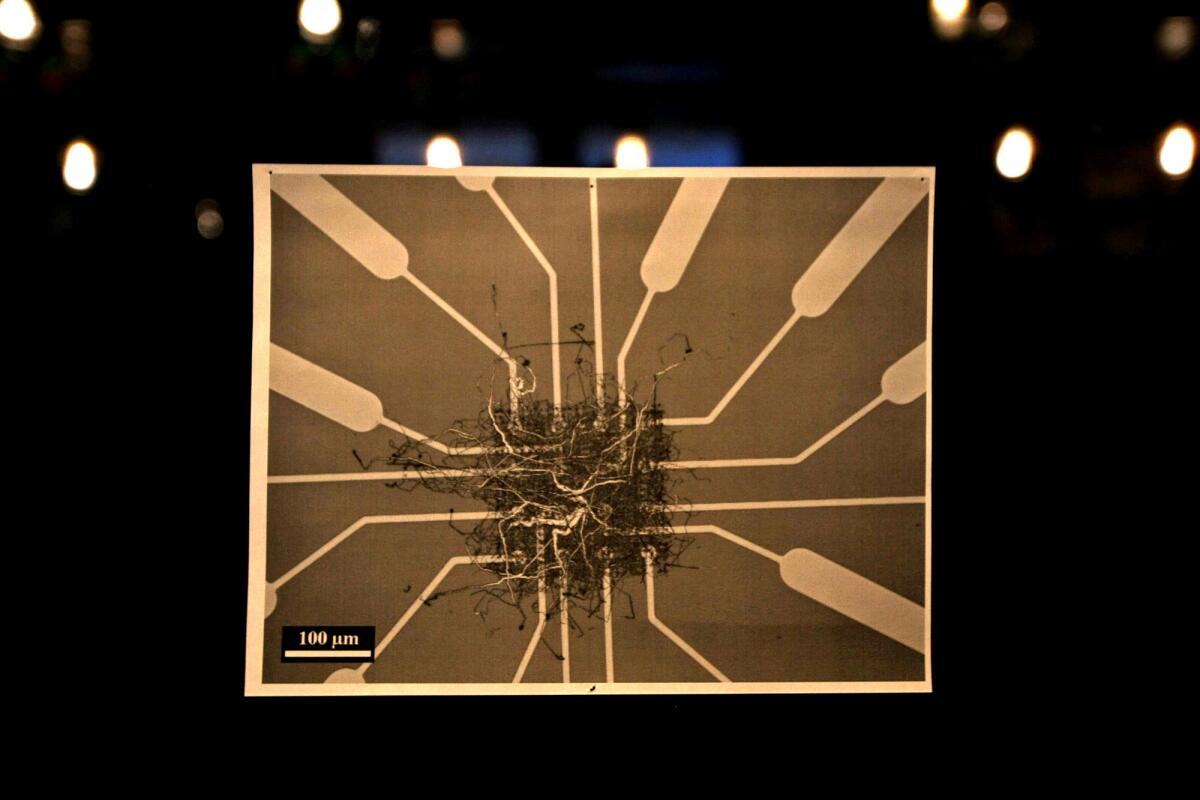
A macro photograph of one of Gimzewski's computer chips, taken by Sillin, hangs on the wall of Gimzewski's lab. The silicon wafer is no bigger than a quarter, and at its center is an ugly tangle of wires randomly crisscrossed and interwoven like hairs in a tiny dust ball. More photos
To explain his research into the dust ball, Gimzewski starts scribbling on a white board. He begins with Alan Turing, who in 1950 raised the question that has provoked scientists ever since: "Can machines think?"
The quest for artificial intelligence took the human brain as its model, and its early proponents believed that computers would provide the answer to Turing's question. But Gimzewski thinks they had it wrong, even as the quest for artificial intelligence continues to push ahead with more sophisticated software and more efficient microprocessors.
He draws two boxes and labels one "processor" and the other "memory." He runs arrows between them and explains the limitations of these components, the essential operating systems of any computer today.
They draw too much energy, he says. They overheat. They slow down when communicating with one another. Most crucially, though, their calculations are contingent upon their programming. For a computer to make sophisticated mathematical calculations, it first needs to be told that 1+1=2.
Research is about making discoveries by doing the crazy things that most people say won't work.”
But intelligence, Gimzewski says, is not extrapolation or the ability to calculate Pi to the 32nd millionth place with the help of a new algorithm. Intelligence is the ability to adapt to surroundings, learn from mistakes, draw conclusions and react without instructions, no matter the consequences.
"Randomness is needed for intelligence," says Robert Kozma, a collaborator with Gimzewski and a professor of mathematics at the University of Memphis. "Determinism — the opposite of randomness — is the shortcoming of traditional artificial intelligence.... There should be something that comes out of the system that we didn't put into it."
Gimzewski's research is one of nearly a dozen international projects aimed at building a more brain-like computer. As fantastic as this attempt to elicit a lifelike response from a seemingly inanimate object might seem, the project's funding from the Pentagon's Defense Advanced Research Projects Agency and Japan's National Institute for Material Science gives evidence to its credibility.
Bart Kosko, professor of electrical engineering at USC, said the Pentagon's backing is evidence that the research is "credible and certainly not kooky."
Gimzewski concedes that his idea is a mind-bender, but he embraces the skepticism.
"Research is about making discoveries by doing the crazy things that most people say won't work," he says.

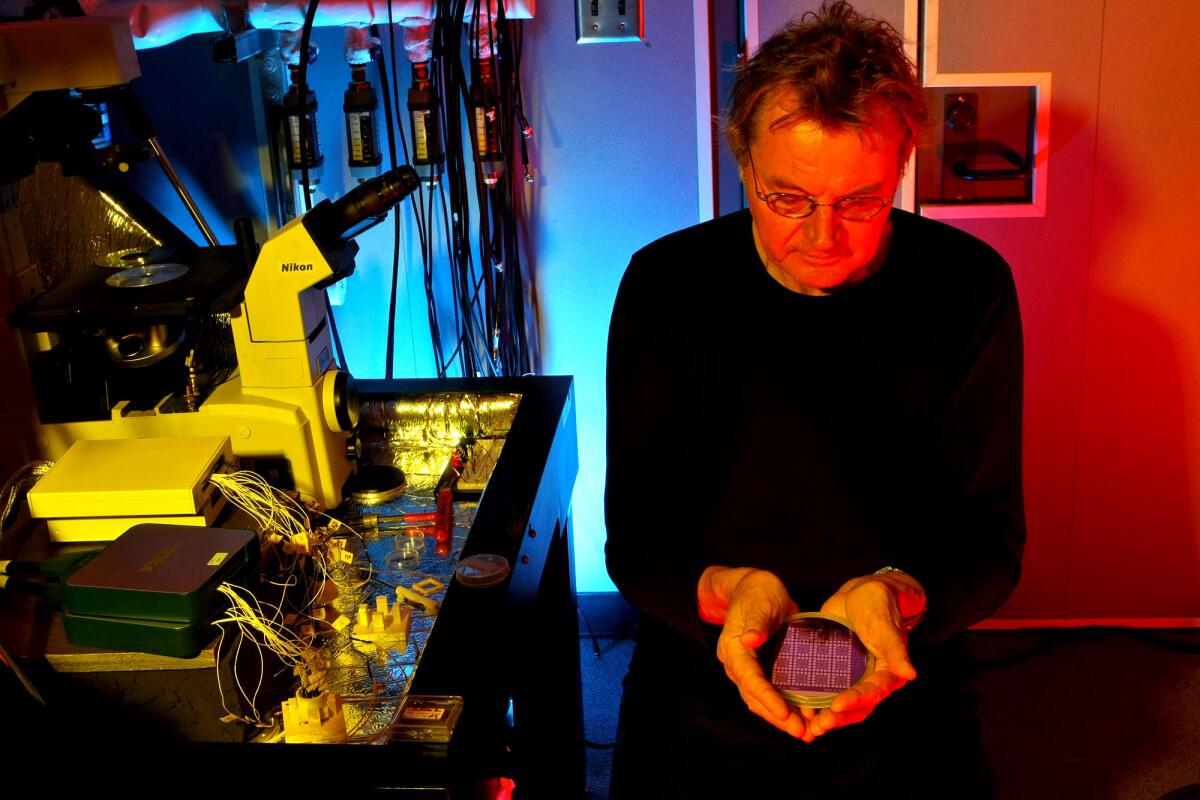
Gimzewski holds a petri dish of silicon computer chips that are being used in his experiment to build a more brain-like computer. More photos
In the field of behavioral science, few tests are simpler than the T-maze for assessing intelligence.
Place a rat in T-shaped box. When it comes to the end of the open leg, it turns either left or right. Food or an attractive scent lies at one end, so that the next trip down the maze, the rat remembers which direction to head.
Last July, Gimzewski's dust ball performed a similar feat in a series of repeated experiments. It turned left at the end of the open leg, an action based on an electrical impulse it had received seconds earlier.
Gimzewski and his co-principal investigator, Adam Stieg, began developing this chip in 2008. Using a microscope that provides images of individual atoms on surfaces, they noticed an exchange of atoms between two wires.
The movement reminded Gimzewski of a synapse, and he wondered if it would be possible to produce a similar exchange in greater numbers. He Googled images of the brain, and Stieg, drawing on his background in electrochemistry, had an idea.
In a lab, they placed a series of copper wire posts, mounted on a silicon wafer, into a solution of silver. As the copper dissolved, the silver formed intricate hair-like strands, as complex as the human cortex. It was the birth of the dust ball.
Building the chip is "extraordinarily simple," Stieg says. Once the strands are created, they are exposed to sulfur, which provides electrical and ionic conductivity, and when electrical signals are sent through them, atoms migrate through each intersection of silver, each strand over strand.
Much as stimulus changes the brain by building over time synaptic patterns that can be associated to memory, the signals over time change the structure of the chip. Bridges form between the strands, further altering the chip.
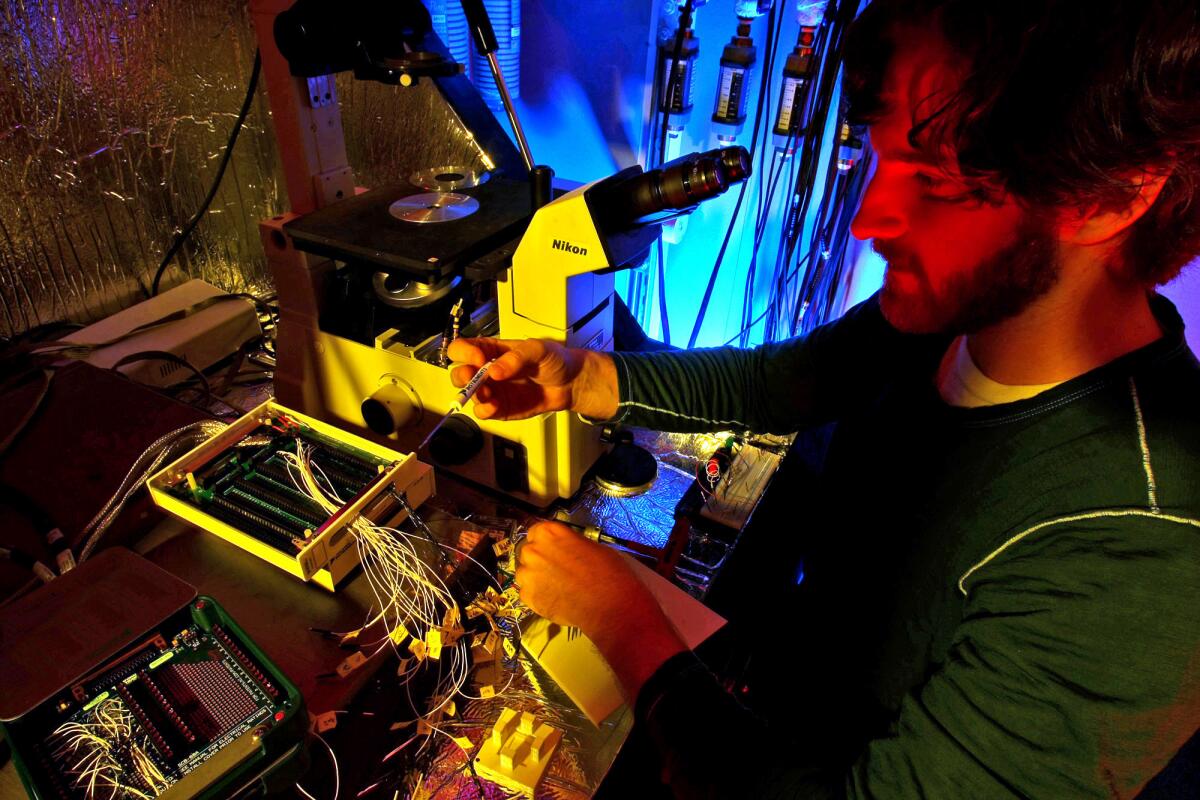
Sillin works inside the "Faraday cage," which is part of Gimzewski's efforts to build a more brain-like computer. "We should have walked away," Sillin says, "but it never failed enough for us to give up." More photos
Gimzewski and his team are studying these patterns, which they believe constitute the memory of the chip. By monitoring the signals that come out of the chip, they can see how the chip integrates, processes and stores the information it receives.
"No one has built a circuit that imitates natural phenomena," he says.

Though early in its development, the work has drawn guarded praise.
"I think Jim is doing great science," says Wei Lu, an associate professor of nanoelectronics at the University of Michigan. "In the beginning it is always a pipe dream, but his chip is a neat approach to creating a system that is close to a biological system."
Lu, however, has his reservations. He believes that the dust ball's arbitrary construction will make it difficult to study.
"Because you don't know how it's wired, you will have limited access to its network," Lu says. In other words, the dust ball may be smart, but scientists might not be able to decipher its intelligence.
If there is a mystery in the process, that's fine with Gimzewski. There is mystery in how the brain works, and the dust ball is not only the summation of his work but also a philosophical leap in the science.
"It is no longer about trying to make atoms do our bidding," he says, referring to the development of computers in the 1940s to predict nuclear reaction. "Instead, it's a matter of watching what atoms do and using their behaviors to help us understand the world."
Follow Thomas Curwen(@tcurwen) on Twitter
Follow @latgreatreads on Twitter
More great reads
Actors draw med school students into caregiver role

It's a rare opportunity to do improv without comedy. Everything that defines acting is here.”
Sign up for Essential California
The most important California stories and recommendations in your inbox every morning.
You may occasionally receive promotional content from the Los Angeles Times.
